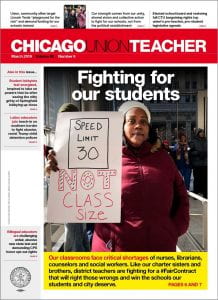 By Jackson Potter, Chicago teacher
By Jackson Potter, Chicago teacher
The day following my departure from the Chicago Teachers Union I was wracked with doubt. Wondering whether I had done the right thing? Could I teach after an 8 year hiatus? I worried about my colleagues and co-workers at the union, whether I had made a decision that could be harmful to members or community partners, amongst a litany of other broken and random thoughts that wracked my brain as I underwent a drastic change in identity and schedule.
I haven’t journaled in years, but in reaching the end of my 8 year tenure at the CTU and feeling a need to write down my observations and complicated emotions about the transition, here are some of my initial thoughts:
1) Union leadership can easily ossify without sufficient planning for succession and willingness of others to take on different roles. Making room for new leadership and exhibiting a willingness to transfer roles and responsibilities in a deliberate and intentional way.
2) This move demonstrates to the caucus and the rank and file generally, that the union leadership sees itself as symbiotically linked to the day to day reality of the classroom experience. A constant effort to do that concretely and deliberately, to develop a rotation that embeds itself into the culture of the office and within workplaces is critical. This helps establish an orientation to our program that affirms, recognizes and acts upon bringing a rotation of leaders into union work both inside and outside the CTU office, caucus, etc.
3) To fortify a rank and file strategy that prides itself upon highly functioning organization systems and recruitment into a broader movement to fight racism, for labor rights and, minimally, social democratic transformation of our city and the country.
4) Address systemic problems and issues that have gone unresolved, unanswered, left to fester worsen, etc. Some examples are racial dynamics inside the caucus, ineffective distribution of labor among key activists, inability/ unwillingness to recruit into a more radical agenda and organizing model, outdated communications strategy, etc.
5) Workers are capable of controlling their own destinies and organizations. All that being said, an activist and colleague said to me yesterday that “the idea of leadership returning to membership is principled, ideologically in line with a worker-led, democratic organization is very admirable and yet/still we wished it was some other than you making that move.”
There is also a tendency to over-estimate the nature of “rank and file” leadership. Understanding and executing union work at a high level has a steep learning curve for a variety of key areas of leadership. It took me a couple of years just to get my bearings. I left the union world childless and with an ulcer to show for it, along with plenty of battletested experiences. Like any role where battle with adversaries defines the day to day, we had casualties, people who got tired, fed up, disillusioned. However, like with teaching itself, it takes time to get the skills necessary to become confident, competent and capable. We cannot afford to idealize the nature of union work at our own peril of over-simplifying the tasks at hand, the skills needed to accomplish key tasks or the leadership development necessary to reproduce and enliven our models.
I’ve realized anew that working as a teacher is pretty isolating form of intellectual production and application. Despite the numerous sessions with new colleagues this summer where we have merged our intellectual ideas and creative impulses to create dynamic lesson plans, the majority of the conceptualization, materials and orientation come from sitting alone reading and writing at my desk. I have spent more time in the last month occupied within the deep recesses of my mind sitting at a computer, in front of a book, or flipping through a curriculum binder than I have in nearly a decade.
In contrast, union work was profoundly collective relative to the intellectual production involved in outlining a new course. While I disliked the extent of time where I was at my computer designing agendas and developing staff plans … a good percentage of my day was spent talking to colleagues/community organizers/ and other teacher union staff from around the country about strategy, member problems, and campaigns we were part of. The job was intensely collective compared to the largely individualistic work of teaching… though students bring another huge dimension into the school community work
This divergence in lifestyle and job complex has also got me thinking of the need to give more of our members in particular and workers in general the exposure to collective action and campaign development that union workers are constantly swimming in. It’s no wonder that after a summer of pontification, mental rest, vacation and constant deliberation separated from the action and bustle of classroom instruction, that our members could feel a bit alienated and isolated from colleagues and the union.
Whereas on the union side we are still going full throttle summer program of member outreach where 30 to 40 members go through intensive organizing training and staff develop new strategies to address contract issues, staff restructuring, etc… My best guess is that much of our activity is like a tree that falls in the woods for most people. No one sees it or feels it and therefore a perception develops that our we are sitting on our laurels. It’s not unlike the dilemma described by Engler and Engler in their new book This is an Uprising where movements fail to take credit for the advances they achieve, they will sputter and fade more quickly and have less to show for their efforts. From the vantage point of a member outside of the office, it’s starkly obvious to me now that we need a much more robust method for making sure the membership and greater public feel and see our work in a comprehensive, engaging and constant manner.
